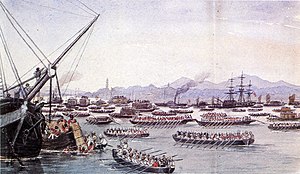Battle of Canton (May 1841)
| date | May 21, 1841 to May 30, 1841 |
|---|---|
| place | Canton , China |
| output | British victory |
| Parties to the conflict | |
|---|---|
| Commander | |
| Troop strength | |
| 6000 men 9 ships |
45,000 men 4 cont |
| losses | |
|
15 dead |
1000 dead |
At the Battle of Canton from May 21 to 26, 1841, British troops crushed the organized resistance of Chinese troops near Canton after a failed attack by the Qing military during the First Opium War . The Chinese commander, Yishan , was forced by the military situation to conclude a ceasefire with the British, after which the British troops cleared the immediate vicinity of the city in return for diplomatic concessions.
background
After the military defeats under Lin Zexu and Qishan , Emperor Daoguang commissioned Generals Yishan and Yang Fang to destroy the British expeditionary troops in southern China. Qishan was to be given command of 17,000 soldiers who were ordered to Guangdong from other provinces . The Qing also set up local militias of around 36,000 men. Shortly after his arrival in Canton, Yishan took up messages with the Commander-in-Chief of the British Charles Elliot and advised him, referring to the numerical superiority of the Chinese armed forces, to seek a peace treaty.
Yishan planned a surprise attack, relying primarily on lightships and irregular coastal marines. As Yong, the irregulars were only temporarily recruited for military service. Yishan carried out the attack with only a small fraction of his forces - 1,000 soldiers and 700 yong. At the time of the attack, the reinforcements promised to him had not yet arrived in full in Canton. The target of the attack was the trading district of the Thirteen factories in Canton, which the British had occupied in March of that year. The main part of Yishan's armed forces consisted of ground troops, which could not intervene in sea battles. Yishan distributed his 25,000 soldiers to Canton and the surrounding area in order to be able to guarantee a defense on land. The largest contingents were 4,500 men in Yantang and 4,300 men on the city wall of the new town . The rest were assigned to various positions in smaller contingents of 1,000 to 2,500 men.
course
On May 21, 1841, the British warships Modeste , Algerine , Pylades , Nemesis and Louisa lay in front of the thirteen factories, as well as the armed merchant ship Aurora . At 11 p.m. the British sighted around one hundred lightships approaching them, some of which had already been set on fire. The British ships were able to evade these and effectively take them under fire. This also led to an artillery battle with the Chinese coastal batteries. A similar attack was carried out against the Alligator west of Canton at the same time. The fireboat and Yong attacks collapsed quickly and resulted in no losses to British ships. On March 23, 1841, however, Yishan reported in a factual report to Daoguang the destruction of two British warships by fire and the death of numerous British soldiers.
On the same day, British reinforcements appeared, which Elliot had requested from Hong Kong days before the battle . The strength of the British expedition fleet off Canton was thus eleven conventional warships, two steam-powered warships, around 2,300 army soldiers and 1,200 members of the Royal Navy . On the same day the Sulfur carried out a reconnaissance mission upstream. In this, they destroyed 28 Chinese sea vessels. The following day the British opened the battle with two separately operating naval units, which took the coastal fortifications from east and west under fire. In the center of the battlefield, the steam-powered warship Nemesis dropped the roughly 2,300 foot soldiers.
These carried a total of ten artillery pieces and two rocket launchers . The British quickly managed to take out the remaining soldiers and fortifications. After a day without a fight, the British landing detachment took the heights north of the city on May 26, 1841. On the same day, the white flag was hoisted in the city as it was now under fire from two sides. British troops counted 15 dead and 112 wounded in their own ranks.
consequences
Due to the military situation, Yishan agreed to an agreement with Elliot. According to this, Yishan should withdraw his troops from the city, pay six million yuan for the expenses of the British expedition and also compensate the costs for the destruction and looting of the factories. In return, the British fleet would withdraw across the Humen and the soldiers would evacuate the coast. Yishan could not keep the defeat a secret from Daoguang, but attributed it in his reports to traitors to Han who had provided the ground forces of the attack and who had come out of nowhere. The agreement was fulfilled by Yishan before the agreed date and the British vacated the canton by June 1, 1841.
During the short stay of the British in Guangdong, Sanyuanli was confronted with a spontaneous peasant militia of tens of thousands.
Individual evidence
- ↑ a b c d e Julia Lovell: The Opium War. 2nd edition, London 2012, pp. 148–155
- ↑ Mao Haijian: The Qing Empire and the Opium War - The Collapse of the Heavenly Dynasty. Cambridge 2016, p. 237
- ↑ a b c d Mao Haijian: The Qing Empire and the Opium War - The Collapse of the Heavenly Dynasty. Cambridge 2016, pp. 239–245

